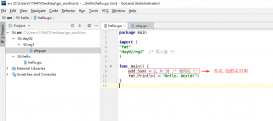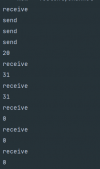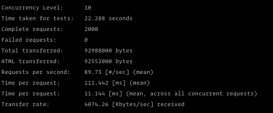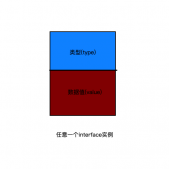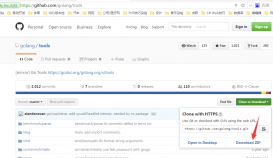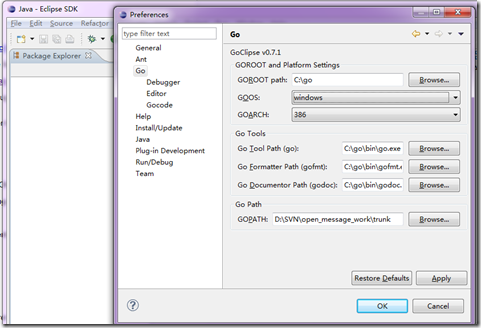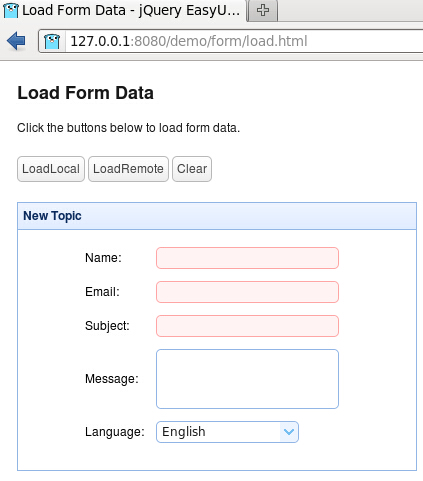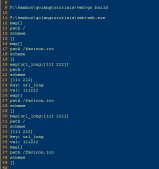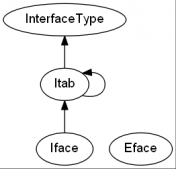一、sturct json tag的使用
1.tag格式说明
struct json tag主要在struct与json数据转换的过程(Marshal/Unmarshal)中使用。
json的tag格式如下:
Key type `json:"name,opt1,opt2,opts..."`
说明:
- 变量必须是可导出的(Key首字母必须大写),否则会被忽略处理。
- 没有json tag或者tag中name省略(但不能少了","),默认使用字段名。
- name要注意命名的有效性。
- opt1、opt2等项为可选项,必须使用有限的几个限定的opt的一个或组合,如"omitempty"、"string",使用非限定的opt会发生错误。
2.具体使用格式说明
我们先介绍下源码文档中提供的几种使用方式:
因Marshal与Unmarshal是相反的过程,两者规则是一致的,以下介绍中仅说明了Marshal时的处理。
(1)不指定tag
Field int // “Filed”:0
不指定tag,默认使用变量名称。转换为json时,key为Filed。
(2)直接忽略
Field int json:"-" //注意:必须为"-",不能带有opts
转换时不处理。
(3)指定key名
Field int json:"myName" // “myName”:0
转换为json时,key为myName
(4)"omitempty"零值忽略
Field int json:",omitempty"
转换为json时,值为零值则忽略,否则key为myName
(5)指定key且零值忽略
Field int json:"myName,omitempty"
转换为json时,值为零值则忽略,否则key为myName
(6)指定key为"-"
Field int json:"-," // “-”:0
此项与忽略的区别在于多了个”,“。
(7)“string” opt
以上提到的用法都是常见的,这个比较特殊。
"string"仅适用于字符串、浮点、整数或布尔类型,表示的意思是:将字段的值转换为字符串;解析时,则是将字符串解析为指定的类型。主要用于与javascript通信时数据的转换。
注意:
仅且仅有"string",没有int、number之类的opt。即带"string" opt的字段,编码时仅能将字符串、浮点、整数或布尔类型转换为string类型,反之则不然;解码时可以将string转换为其他类型,反之不然。因为"string"有限制。
Int64String int64 json:",string" // “Int64String”:“0”
“string” opt的使用可以在Marshal/Unmarshal时自动进行数据类型的转换,减少了手动数据转换的麻烦,但是一定要注意使用的范围,对不满足的类型使用,是会报错的。
猜下对string使用"string" opt的结果会是如何呢?
Int64String string json:",string"
我们在了解源码后解答。
二、源码角度的设计处理过程
一切的使用方式肯定在设计时就已限定,我们现在看看源码中的处理过程。
在看实现的过程中,可以思考下使用的方式对不对,还有要注意的地方吗?
对某些地方非常好的实现思路,我们也可以借鉴下,对以后的编程学习大有裨益。
此处为了简洁,具体调用过程略过不讲,直接查看核心代码部分,有兴趣的话,可以查看下完整过程。
1.typeFields
在typeFields中详细的对上面提到的各种用法的tag做了处理,处理后的数据存入fileds,最后在进行编码。
|
1
2
3
4
5
6
7
8
9
10
11
12
13
14
15
16
17
18
19
20
21
22
23
24
25
26
27
28
29
30
31
32
33
34
35
36
37
38
39
40
41
42
43
44
45
46
47
48
49
50
51
52
53
54
55
56
57
58
59
60
61
62
63
64
65
66
67
68
69
70
71
72
73
74
75
76
77
78
79
80
81
82
83
84
85
86
87
88
89
90
91
92
93
94
95
96
97
98
99
100
101
102
103
104
105
106
107
108
109
110
111
112
113
114
115
116
117
118
119
120
121
122
123
124
125
126
127
128
129
130
131
132
133
134
135
136
137
138
|
// typeFields returns a list of fields that JSON should recognize for the given type.// The algorithm is breadth-first search over the set of structs to include - the top struct// and then any reachable anonymous structs.func typeFields(t reflect.Type) structFields { // Anonymous fields to explore at the current level and the next. current := []field{} next := []field{{typ: t}} // Count of queued names for current level and the next. var count, nextCount map[reflect.Type]int // Types already visited at an earlier level. visited := map[reflect.Type]bool{} // Fields found. var fields []field // Buffer to run HTMLEscape on field names. var nameEscBuf bytes.Buffer for len(next) > 0 { current, next = next, current[:0] count, nextCount = nextCount, map[reflect.Type]int{} for _, f := range current { if visited[f.typ] {//已处理的过类型跳过 continue } visited[f.typ] = true // Scan f.typ for fields to include. for i := 0; i < f.typ.NumField(); i++ { sf := f.typ.Field(i) isUnexported := sf.PkgPath != "" if sf.Anonymous {//内嵌类型的处理 t := sf.Type if t.Kind() == reflect.Ptr { t = t.Elem() } if isUnexported && t.Kind() != reflect.Struct { // Ignore embedded fields of unexported non-struct types. continue//非struct结构的不能导出的key直接跳过 } // Do not ignore embedded fields of unexported struct types // since they may have exported fields. } else if isUnexported { // Ignore unexported non-embedded fields. continue//不能导出的key直接跳过 } tag := sf.Tag.Get("json") if tag == "-" { continue//tag为"-"直接跳过 } name, opts := parseTag(tag) if !isValidTag(name) { name = ""//包含特殊字符的无效name } index := make([]int, len(f.index)+1) copy(index, f.index) index[len(f.index)] = i ft := sf.Type if ft.Name() == "" && ft.Kind() == reflect.Ptr { // Follow pointer. ft = ft.Elem() } // Only strings, floats, integers, and booleans can be quoted. quoted := false if opts.Contains("string") {//此处为"string" opt的特殊处理,支持的类型如下: switch ft.Kind() { case reflect.Bool, reflect.Int, reflect.Int8, reflect.Int16, reflect.Int32, reflect.Int64, reflect.Uint, reflect.Uint8, reflect.Uint16, reflect.Uint32, reflect.Uint64, reflect.Uintptr, reflect.Float32, reflect.Float64, reflect.String: quoted = true } } // Record found field and index sequence. if name != "" || !sf.Anonymous || ft.Kind() != reflect.Struct { tagged := name != "" if name == "" { name = sf.Name//未指定或者指定name无效的使用原field的name } field := field{ name: name, tag: tagged, index: index, typ: ft, omitEmpty: opts.Contains("omitempty"),//omitempty确认 quoted: quoted,//是否支持"string" opt } field.nameBytes = []byte(field.name) field.equalFold = foldFunc(field.nameBytes) // Build nameEscHTML and nameNonEsc ahead of time. //两种格式的构建 nameEscBuf.Reset() nameEscBuf.WriteString(`"`) HTMLEscape(&nameEscBuf, field.nameBytes) nameEscBuf.WriteString(`":`) field.nameEscHTML = nameEscBuf.String() field.nameNonEsc = `"` + field.name + `":` fields = append(fields, field)//存入fields if count[f.typ] > 1 { // If there were multiple instances, add a second, // so that the annihilation code will see a duplicate. // It only cares about the distinction between 1 or 2, // so don't bother generating any more copies. fields = append(fields, fields[len(fields)-1]) } continue } // Record new anonymous struct to explore in next round. nextCount[ft]++ if nextCount[ft] == 1 { next = append(next, field{name: ft.Name(), index: index, typ: ft}) } } } } ... for i := range fields { f := &fields[i] f.encoder = typeEncoder(typeByIndex(t, f.index))//设置fields的encoder } nameIndex := make(map[string]int, len(fields)) for i, field := range fields { nameIndex[field.name] = i } return structFields{fields, nameIndex}} |
2.encode
|
1
2
3
4
5
6
7
8
9
10
11
12
13
14
15
16
17
18
19
20
21
22
23
24
25
26
27
28
29
30
31
32
33
34
35
36
37
38
39
40
41
42
|
func newStructEncoder(t reflect.Type) encoderFunc { se := structEncoder{fields: cachedTypeFields(t)} return se.encode}func (se structEncoder) encode(e *encodeState, v reflect.Value, opts encOpts) { next := byte('{')FieldLoop: for i := range se.fields.list { f := &se.fields.list[i] // Find the nested struct field by following f.index. fv := v for _, i := range f.index { if fv.Kind() == reflect.Ptr { if fv.IsNil() { continue FieldLoop } fv = fv.Elem() } fv = fv.Field(i) } if f.omitEmpty && isEmptyValue(fv) {//"omitempty"的忽略处理,需要值为零值 continue } e.WriteByte(next) next = ',' if opts.escapeHTML { e.WriteString(f.nameEscHTML) } else { e.WriteString(f.nameNonEsc) } opts.quoted = f.quoted f.encoder(e, fv, opts)//根据具体类型的编码处理 } if next == '{' { e.WriteString("{}") } else { e.WriteByte('}') }} |
以下以int类型intEncoder为例:
|
1
2
3
4
5
6
7
8
9
10
|
func intEncoder(e *encodeState, v reflect.Value, opts encOpts) { b := strconv.AppendInt(e.scratch[:0], v.Int(), 10) if opts.quoted {//带有"string" opt添加引号 e.WriteByte('"') } e.Write(b) if opts.quoted { e.WriteByte('"') }} |
对于数字类型,如果带有**“string”**则在写入正式值前后添加引号。
对于字符串类型,如果带有**“string”**,原string值再编码时会添加引号,再对结果添加引号,则格式异常,因此需要先对原值进行编码。
|
1
2
3
4
5
6
7
8
9
10
11
12
13
14
15
16
17
18
19
20
21
22
23
24
25
26
27
28
29
30
31
32
33
34
35
36
37
38
39
40
41
42
43
44
45
46
47
48
49
50
51
52
53
54
55
56
57
58
59
60
61
62
63
64
65
66
67
68
69
70
71
72
73
74
75
76
77
78
79
80
81
82
83
84
85
86
87
88
89
90
91
92
93
94
95
|
func stringEncoder(e *encodeState, v reflect.Value, opts encOpts) { if v.Type() == numberType { numStr := v.String() // In Go1.5 the empty string encodes to "0", while this is not a valid number literal // we keep compatibility so check validity after this. if numStr == "" { numStr = "0" // Number's zero-val } if !isValidNumber(numStr) { e.error(fmt.Errorf("json: invalid number literal %q", numStr)) } e.WriteString(numStr) return } if opts.quoted { sb, err := Marshal(v.String())//注意此处处理 if err != nil { e.error(err) } e.string(string(sb), opts.escapeHTML) } else { e.string(v.String(), opts.escapeHTML) }}func (e *encodeState) string(s string, escapeHTML bool) { e.WriteByte('"')//添加引号 start := 0 for i := 0; i < len(s); { if b := s[i]; b < utf8.RuneSelf {//字符串中存在特殊的字符时的转义处理 if htmlSafeSet[b] || (!escapeHTML && safeSet[b]) { i++ continue } if start < i { e.WriteString(s[start:i]) } e.WriteByte('\\') switch b { case '\\', '"': e.WriteByte(b) case '\n': e.WriteByte('n') case '\r': e.WriteByte('r') case '\t': e.WriteByte('t') default: // This encodes bytes < 0x20 except for \t, \n and \r. // If escapeHTML is set, it also escapes <, >, and & // because they can lead to security holes when // user-controlled strings are rendered into JSON // and served to some browsers. e.WriteString(`u00`) e.WriteByte(hex[b>>4]) e.WriteByte(hex[b&0xF]) } i++ start = i continue } c, size := utf8.DecodeRuneInString(s[i:]) if c == utf8.RuneError && size == 1 { if start < i { e.WriteString(s[start:i]) } e.WriteString(`\ufffd`) i += size start = i continue } // U+2028 is LINE SEPARATOR. // U+2029 is PARAGRAPH SEPARATOR. // They are both technically valid characters in JSON strings, // but don't work in JSONP, which has to be evaluated as JavaScript, // and can lead to security holes there. It is valid JSON to // escape them, so we do so unconditionally. // See http://timelessrepo.com/json-isnt-a-javascript-subset for discussion. if c == '\u2028' || c == '\u2029' { if start < i { e.WriteString(s[start:i]) } e.WriteString(`\u202`) e.WriteByte(hex[c&0xF]) i += size start = i continue } i += size } if start < len(s) { e.WriteString(s[start:]) } e.WriteByte('"')} |
在了解完源码的处理过程后,我们对之前提到的问题做个解答。对string类型的字段添加"string" opt,得到的是:
Int64String string json:",string" // “Int64String”: "“1234"”
三、总结
本文主要从源码的角度说明struct json tag的为什么这么使用,以及使用时需要注意的地方。最后重复下重要的几点:
- 字段必须可导出,tag才有意义
- 忽略必须使用json:"-",不得带有opts,否则key将会变成"-"
- "string" opt仅适用于字符串、浮点、整数及布尔类型,意思是可以将这些类型的数据Marshal为string类型,或者将string类型的数据Unmarshal为这些类型。
请勿滥用,尤其是对已经是string类型的数据使用。
到此这篇关于golang struct json tag使用的文章就介绍到这了,更多相关golang struct json tag的使用内容请搜索服务器之家以前的文章或继续浏览下面的相关文章希望大家以后多多支持服务器之家!
原文链接:https://blog.csdn.net/xz_studying/article/details/106012535



